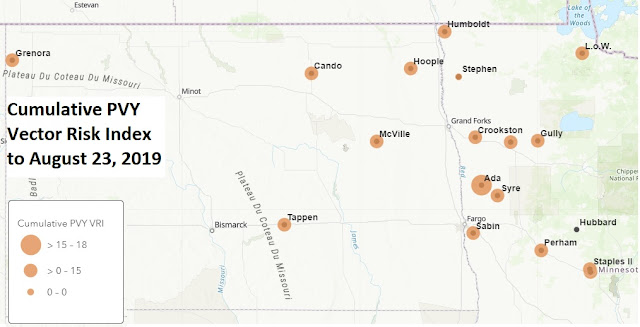Trap Catches Identified to July 26, 2019.
Greetings
The trap counts are up in several locations and the cereal aphids are starting to fly. It looks like the late July / early August vector flights are starting. Trap catches are up overall and the hotspot this week was Crookston and Ada reporting 22 and 20 vector aphids each.
Most spots are reporting some cereal aphids, mostly English Grain Aphid and some Corn Leaf Aphid, not a lot of Bird-Cherry Oat Aphid so far this year. Several sites reported Soybean Aphid, so the Sturgis Dispersal Event (thanks Bruce Potter for one of the most evocative terms for a dispersal event) seems to be on time, albeit very small because of the very low numbers in most parts of the North Central region. This dispersal is unlikely to develop into much of a problem in most locations given the low number of individuals involved and the maturity of soybeans in most locations.
Other species with higher populations this week included Cotton Melon and Black Bean aphids. Damson Hop aphids and Cannabis aphids were absent this week.
So, it looks like things may be heat
ing up. And this means so are the chances for the spread of PVY. Remember, the application of oil is recommended as a mechanism of reducing the spread of PVY.
Aphid Fact of the Week - Many of the aphid species that vector (transmit) PVY in potatoes will not colonize potatoes. At this time of year, many aphid species develop a winged generation to disperse from host plants that are beginning to senesce (like cereal crops) and are seeking greener fields (literally). When they enter a potato field, they will probe a plant to determine if it's a suitable food host, somewhere they can leave a daughter to start a new colony. Aphid species that can feed on potato will leave a live daughter and may feed for a period before moving on. Aphids for whom potatoes are not a food source will continue through a field probing plants until they eventually leave the field. This probing activity can move any PVY virus present in the field to uninfected plants. The more aphids crossing the field, the greater the chances for PVY movement. So while aphids colonizing potatoes are a sign that PVY spread may be occurring, the absence of aphid colonies on potato plants doesn't mean it isn't happening. Using trap data (suction or pan), sticky cards, field scouting, etc will all contribute to good estimates of vector presence.
As always, keep on scouting!
Click on any image below for full-scale version.
Cumulative PVY Vector Risk Index to July 26, 2019.
Cumulative PVY Vector Risk Index for 2018 (for comparison)
Aphid Species Capture and PVY Vector Risk Index for July 19-26, 2019
Cumulative Aphid Species Capture and PVY Vector Risk Index to July 26, 2019

































